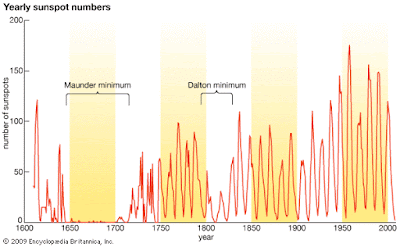http://theclimatescepticsparty.blogspot.com/2018/02/sun-is-cooling-are-we-heading-for.html
 |
| Graph of average yearly sunspot numbers showing the 11-year solar cycle. Encyclopædia Britannica, Inc. |
In a journal of the American Astronomical Society, The Astrophysical Journal Letters, an article:
Ultraviolet Flux Decrease Under a Grand Minimum from IUEShort-wavelength Observation of Solar Analogs (link)
Dan Lubin, Carl Melis and David Tytler: The Astrophysical Journal Letters, Volume 852, Number 1
Abstract
 , and eight stars have log
, and eight stars have log  . The IUE-observed flux spectra are integrated over the wavelength range 1250–1910 Å, transformed to surface fluxes, and then normalized to solar B − V. These normalized surface fluxes show a strong linear relationship with activity
. The IUE-observed flux spectra are integrated over the wavelength range 1250–1910 Å, transformed to surface fluxes, and then normalized to solar B − V. These normalized surface fluxes show a strong linear relationship with activity  (R 2 = 0.857 after three outliers are omitted). From this linear regression we estimate a range in UV flux of 9.3% over solar cycle 22 and a reduction of 6.9% below solar cycle minimum under a grand minimum. The 95% confidence interval in this grand-minimum estimate is 5.5%–8.4%. An alternative estimate is provided by the IUE observations of τCet (HD 10700), a star having strong evidence of being in a grand-minimum state, and this star’s normalized surface flux is 23.0 ± 5.7% lower than solar cycle minimum.
(R 2 = 0.857 after three outliers are omitted). From this linear regression we estimate a range in UV flux of 9.3% over solar cycle 22 and a reduction of 6.9% below solar cycle minimum under a grand minimum. The 95% confidence interval in this grand-minimum estimate is 5.5%–8.4%. An alternative estimate is provided by the IUE observations of τCet (HD 10700), a star having strong evidence of being in a grand-minimum state, and this star’s normalized surface flux is 23.0 ± 5.7% lower than solar cycle minimum.
What does it mean?
The Encyclopædia Britannica explains:
Maunder minimum, unexplained period of drastically reduced sunspot activity that occurred between 1645 and 1715.
Sunspot activity waxes and wanes with roughly an 11-year cycle. In 1894 the English astronomer Edward Walter Maunder pointed out that very few sunspots had been observed between 1645 and 1715. Astronomers such as John Flamsteed and Gian Domenico Cassini who did observe sunspots during that period noted that they were the first they had seen in years. However, most of Maunder’s fellow astronomers blamed the lack of sunspots on haphazard and sporadic observations of the Sunby 17th- and 18th-century astronomers. (Read more: Encyclopædia Britannica)
News.com’s Jamie Seidel (link)
BY 2050, our Sun is expected to be unusually cool.It’s what scientists have termed a ‘grand minimum’ — a particularly low point in what is otherwise a steady 11-year cycle.
Over this cycle, the Sun’s tumultuous heart races and rests.
At its high point, the nuclear fusion at the Sun’s core forces more magnetic loops high into its boiling atmosphere — ejecting more ultraviolet radiation and generating sunspots and flares.
When it’s quiet, the Sun’s surface goes calm.It ejects less ultraviolet radiation.
As an astrophysicist, let me agree with UC San Diego physicist Dan Lubin about the probability of a grand minimum of solar cycles during this century. We have already seen a drop in sunspot number since the 1960s, and a more dramatic falloff since the turn of the century. That portends a colder climate, as was observed during the Maunder Minimum and to a lesser extent during the Dalton Minimum long ago.
Combining this downward trend in solar activity with an expected shift in the Pacific Decadal Oscillation toward a negative value (more La Niñas), you have a very clear signal for a cooler climate.
And with an advancing Milankovitch Cycle toward lower obliquity (less tilt in the earth’s axis) at a time when insolation (incoming solar radiation) peaks in the Southern Hemisphere summer, the Earth finds itself on the brink of another 100,000 year Ice Age. The present Interglacial we call the Holocene Climate Optimum has now lasted about as long as previous Interglacials, and we are very likely to fall into another Ice Age this Millennium. This fall will take centuries, because our oceans contain the vast majority of mobile heat on this planet and will buffer a descent. Lubin is simply wrong about ‘Global Warming’ saving us. He is apparently unaware or unwilling to admit that the climate models have been VERY wrong about the effects of rising atmospheric CO2. Carbon dioxide has NOT caused the warming that proponents argue it should. That is why proponents of the paradigm have been dialing back ‘climate sensitivity’ to rising CO2. It still needs to be dialed back a lot more. There is now considerable doubt that we will ever be able to measure a warming signature from CO2, clearly separate from other and much larger natural warming/cooling cycles.
And to make matters still worse for climate alarmists, much of the measured upward trend in atmospheric CO2 is likely due to natural causes also. Human contributions of CO2 are minor compared with the amounts of CO2 regularly exchanged between the atmosphere and other sinks like the biosphere and the oceans. That says that Mother nature is solidly in control here too.
Gordon J. Fulks, PhD (Physics)Corbett, Oregon USA

